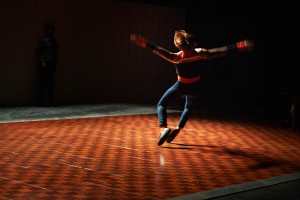
> Intersecting Art, Meaning, Cognition, Technology
August 14-15 2015, Vancouver Canada
Simon Fraser University
http://moco.iat.sfu.ca/
=======================================
Building on the success of the first International Workshop on Movement and Computing (MOCO’14) at IRCAM, we are happy to announce the second edition, MOCO’15 at Simon Fraser University. MOCO’15 will be co-located with ISEA2015 (http://isea2015.org/)
MOCO aims to gather academics and practitioners interested in the computational study, modeling, representation, segmentation, recognition, classification, or generation of movement information. We invite participants interested in exploring how movement experience can contribute to computational knowledge through movement modeling and representation. We welcome researchers that are positioned within emerging interdisciplinary domains between art & science.
While human movement itself focuses on bodily experience, developing computational models for movement requires abstraction and representation of lived embodied cognition. Selecting appropriate models between movement and its rich personal and cultural meanings remains a challenge in movement interaction research. This two day workshop seeks to explore an equal and richly nuanced epistemological partnership between movement experience and movement cognition and computational representation.
This second edition of MOCO will bring together people working in interdisciplinary intersections of Human Computer Interaction, Computer Graphics, Machine Learning, Artificial Intelligence, Robotics, Affective Computing, Cognitive Science, Neuroscience, Psychology, and Artists from Media Art, Choreography, Composition, Dance and Design. The workshop aims at promoting scientific and artistic collaborations within this inter-disciplinary boundary. It will offer opportunities to disseminate emerging research works through presentations, demonstrations, and group discussions.
= Suggested Topics
=======================================
* Expressive movement-based interaction
* Machine learning for movement
* Modeling movement qualities
* Gestural control
* Movement generation
* Movement and sound interaction
* Sensori-motor learning with audio/visual feedback
* Embodied cognition and movement
* Visualizing movement
* Modeling kinaesthetic empathy
* Somatic practice and design
* Whole-body interaction
* Expressive movement analysis and synthesis
* Design for movement in digital art
* Semantic models for movement representation
* Laban Movement Studies and computation
* Dance and neuroscience
* Biosensing, biocontrol and movement
* Movement expression in avatar, artificial agents, virtual humans or robots.
* Music and movement
* Movement computation in ergonomics, sports, and health
= Participation to the workshop
=======================================
The workshop is an opportunity to present a research or a collaborative work. Participants will have the possibility to make a presentation of the results of their research on one of the themes of the workshop, and to interact with their scientific, artistic peers, in a friendly and constructive environment.
If you are interested in an oral presentation of your work, please submit a paper and/or a demo and/or a poster.
= Submission
=======================================
The submission categories are:
- Long paper with oral presentation (8 pages maximum)
- Research note with oral presentation (4 pages maximum)
- Short paper with poster presentation (2 pages maximum)
- Short paper with demonstration (2 pages maximum+ Demo proposal form + link to a video).
All submissions should be PDF and use the MOCO’15 template – adapted from ACM SIGCHI template
http://moco.iat.sfu.ca/authors/
Authors of long papers and notes are also invited to propose a demonstration of their system and its use. All demos must be submitted separately. They have to provide the demo proposal form and a link to a video about the work. The demo proposal form is mandatory for all demo submissions and must include technical set-up and space requirements.
Online submission: All submissions must be done through EasyChair
https://easychair.org/conferences/?conf=moco15
All submission must be anonymous and will be peer-reviewed. The MOCO proceedings will be indexed and published in the ACM digital library.
= Important Dates:
=======================================
Submission deadline: 1st of March 2015 (5:00pm PST)
Notification: 1st of May 2015
Early bird registration: 1st june 2015
Early program: 31st June 2015
= Venue
=======================================
Simon Fraser University, Woodward's,
Goldcorp Centre for the Arts, 149 West Hastings Street, Vancouver Canada.
http://www.sfu.ca/sfuwoodwards.html
MOCO15 will be co-located with ISEA2015 (http://isea2015.org/)
= Workshop Chairs
=======================================
* Thecla Schiphorst, SIAT, SFU, Vancouver, Canada
* Philippe Pasquier, SIAT, SFU, Vancouver, Canada
* Sarah Fdili Alaoui, SIAT, SFU, Vancouver, Canada
* Frederic Bevilacqua, Ircam, Paris, France
* Jules Françoise, Ircam, Paris, France
Contact email: moco15@easychair.org
= Local Organization Committee
=======================================
> School of Interactive Arts and Technology
* Thecla Schiphorst, SIAT, SFU, Vancouver, Canada
* Philippe Pasquier, SIAT, SFU, Vancouver, Canada
* Sarah Fdili Alaoui, SIAT, SFU, Vancouver, Canada



